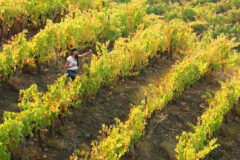Making a case for regenerating forests

Survey leader, Jack Mortimer, twirls a butterfly net in his right hand as he marches along the trail on his way to a transect — then he stops abruptly and concentrates on the loud rustling of leaves in the distance. He had heard rumors back at the research base that woolly monkeys had been spotted just a few hundred meters into the reserve. Could it be them?
With his survey group in tow, Jack carefully weaves through the jungle brush before coming to a small clearing. He hears another rustle up high, but this time, it’s at close proximity. Raising his eyes to meet the noise, he sees a single woolly monkey clinging onto a thick vine not far ahead. This fearless juvenile has Jack’s full attention and jumps up and down in eager bursts, shaking the connecting tree of its leaves, in an effort to warn his terrestrial “invaders” to move out.
Looking up into the towering canopy, now filled by an entire troop of these majestic monkeys, it’s hard to believe that this same stretch of land was little more than a cattle ranch less than 30 years ago.
According to the 2010 Global Forestry Resources Assessment (Global FRA), naturally regenerating — or secondary — forests make up approximately 57 per cent of the world’s forests and two-thirds of tropical forests, alone, are secondary forests.
A regenerating forest is a forest that has suffered some sort of human disturbance, such as through logging or farming, which has caused a loss of forest structure and species diversity by unnatural terms and is now in the process of recovering some sort of its natural structure.
Researchers in Peru’s southeast Amazon have spent the past 10 years studying the 650 hectares of regenerating forest that comprise their research base reserve, which in itself consists of three forest types:
1. CCR (completely cleared and regenerating): this area was systematically cleared
and used intensively;
2. PCR (partially cleared and regenerating): this area was partially cleared and may
have had multiple uses, including agricultural use;
3. SLR (selectively logged and regenerating): large, valuable trees were selectively
logged.
“Primary forests have an amazing value,” Research Coordinator, Jaime Villacampa,
acknowledges, “but the importance of regenerating forests for conservation is growing.”
“We know very little about the patterns of biodiversity on this regenerating forest, how the process of regeneration occurs, which species are most affected by disturbance, and when — or if — they come back.”
As far as regenerating forests go, this plot of forest provides a unique opportunity for scientists interested in looking at biodiversity rates in previously disturbed habitats, in particular.
“This is what we call a best-case scenario,” Jaime explains. “We are in a fully protected area, the regeneration process has been going on for a relatively long period of time — in different areas of the forest between 30-50 years — and we are also very close to the core of the national park, which is fully protected and is a source of animals.”
Because of these conditions, this area has an extremely high level of biodiversity, which also reflects the neighboring national park and region, in general. And in fact, over the past three years, researchers here have been conducting a comparison of species diversity between primary forest sites in this region of the Amazon and regenerating forests of the research base reserve - and they’ve found that between 80-100 per cent of primary forest species richness can be found in the regenerating forest.
In the past month alone, woolly monkeys, spider monkeys, Phyllomedusa camba, and puma and jaguar prints have been spotted here, and interestingly, tapir, an ocelot, and caimans, have all been specifically sighted in the completely cleared and regenerating forest (CCR). Even a lone, three-toed sloth regularly visits a cluster of cecropia trees that overlook the dining area of the camp.
“This shows us that if you leave the forest enough to regenerate, it can actually allow for even sensitive species to come back,” says Jaime.
“So, with woolly monkeys, for example, we’ve seen that during the dry season, when there is less fruit in the forest, they actually come to the most disturbed habitats to feed in.”
As if providing a home for countless endangered species were not a case enough for regenerating forest to be better protected, these forests also provides a slough of social benefits for surrounding communities.
“A healthy forest is going to provide a lot of services,” explains Jaime. “It’s going to provide water purification, control against erosion, control against floods, pest control, and, of course, you’re going to regulate the climate.”
But in a country where the minimum wage is just 750 Peruvian Nuevo Soles per month (approximately £153.45) and secondary forests are usually excluded from national park status and therefore not protected by the law, one of the main threats to Peru’s regenerating rainforests is illegal logging and mining, both of which are lucrative industries that present many locals with the opportunity to quickly improve their social welfare. For Jaime, providing alternative income generation, hand-in-hand with education, is essential to success in the areas of conservation and sustainability.
“If you provide alternative solutions, such as agroforestry where you combine crop plantation with trees or sustainable tourism, you can actually look to a way of providing people with the money that they need,” he says, hopefully. “At the same time, you can make sure that the forest — or the services that the forest and the ecosystems provide — remain intact.”
The formation of nearly 7000 national parks worldwide over the past century has worked to effectively — and simultaneously — protect some of the planet’s most pristine landscapes and threatened ecosystems, such as Serengeti National Park in Tanzania and Fiordland National Park in New Zealand. But as Jaime notes, conservation efforts these days, and particularly in relation to regenerating forests, are increasingly focused on striking a balance between human development and the maintenance of the forest’s natural structure.
“We need to think about moving on from that concern about only protecting primary forest areas and start thinking about how we can manage disturbed habitats and areas that are currently regenerating.”
This means that conservationists may look less towards policy makers to support forest protection in the future and more towards the citizen collective to make a social change.
For as Jaime believes, “If you don’t love it, you’re not going to protect it.”
Written by Katie, Rainforest Journalist for Crees
Tailor-made holidays
Flexible, custom-made holidays to Latin America created to match your exact requirements: our tailor-made itineraries are as unique as the clients for whom they are designed.
Design my tripPapagaio
Your edit for Latin American inspiration
Our exciting range of articles on Latin America explore everything from iconic destinations and lesser-known cultural gems to delicious traditional recipes. You’ll also find exclusive travel tips, first-hand client reviews and the chance to get your personal questions answered by our travel experts.
View Extraordinary Inspiration






































